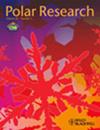The relationship between Antarctic sea-ice extent change and the main modes of sea-ice variability in austral winter
IF 1.9
4区 地球科学
Q3 ECOLOGY
引用次数: 0
Abstract
Accompanying global warming, Antarctic sea-ice extent shows a somewhat increasing trend from 1979 to 2014, followed by an abrupt decrease after 2016. Our previous study examined the change of Antarctic sea-ice extent in austral summer, autumn and spring. In this study, we turn our attention to the austral winter, relating the main modes of sea-ice variability to sea-ice extent in the Pacific, Atlantic and Indian sectors of the Southern Ocean. We find that the modes with the strongest correlation with the sea-ice extent are the third, first and first modes in the Pacific, Atlantic and Indian sectors, respectively. Atmospheric circulation anomalies of zonal wavenumber three over the Southern Ocean, related to planetary wave trains induced by the SST anomalies over the south-western Pacific and the southern Indian oceans, can explain sea-ice concentration anomalies of the third mode in the Pacific sector through thermodynamic and dynamic processes. Sea-ice anomalies of the first modes in the Atlantic and Indian sectors result from atmospheric circulation anomalies of a positive and negative phases of the Southern Annular Mode, respectively. The anomalous Southern Annular Mode is also associated with wave trains over the Southern Ocean excited by SST anomalies over the southern Indian Ocean and the south-western Pacific Ocean. The relationship between SST anomalies and Antarctic sea-ice anomalies can provide a reference for the prediction of Antarctic sea-ice anomalies in austral winter on interannual and decadal timescales.南极海冰范围变化与澳大利亚冬季海冰变化主要模式之间的关系
伴随着全球变暖,南极海冰范围在 1979 年至 2014 年期间呈现出一定程度的增长趋势,2016 年之后则突然下降。我们之前的研究考察了南极夏季、秋季和春季海冰范围的变化。在本研究中,我们将注意力转向了南极冬季,将海冰变化的主要模式与南大洋太平洋、大西洋和印度洋扇区的海冰范围联系起来。我们发现,与海冰范围相关性最强的模式分别是太平洋、大西洋和印度洋扇区的第三、第一和第一模式。太平洋西南部和印度洋南部的海温异常诱发的行星波列与南大洋上空带状波数三的大气环流异常有关,可以通过热力学和动力学过程解释太平洋扇区第三模式的海冰浓度异常。大西洋和印度洋扇区第一模式的海冰异常分别来自南环流模式正相和负相的大气环流异常。南环流模式异常还与南印度洋和太平洋西南部海温异常激发的南大洋波列有关。海温异常与南极海冰异常之间的关系可为预测南极冬季海冰异常提供年际和十年尺度的参考。
本文章由计算机程序翻译,如有差异,请以英文原文为准。
求助全文
约1分钟内获得全文
求助全文
来源期刊

Polar Research
地学-地球科学综合
CiteScore
3.20
自引率
5.30%
发文量
22
审稿时长
>12 weeks
期刊介绍:
Since 1982, Polar Research has been the international, peer-reviewed journal of the Norwegian Polar Institute, Norway''s central institution for research, environmental monitoring and mapping of the polar regions. Aiming to promote the exchange of scientific knowledge about the Arctic and Antarctic across disciplinary boundaries, Polar Research serves an international community of researchers and managers. As an open-access journal, Polar Research makes its contents freely available to the general public.
Original primary research papers comprise the mainstay of Polar Research. Review articles, brief research notes, letters to the editor and book reviews are also included. Special issues are published from time to time.
The scope of Polar Research encompasses research in all scientific disciplines relevant to the polar regions. These include, but are not limited to, the subfields of biology, ecology, geology, oceanography, glaciology and atmospheric science. Submissions from the social sciences and those focusing on polar management and policy issues are welcome. Contributions about Antarctica are particularly encouraged.
 求助内容:
求助内容: 应助结果提醒方式:
应助结果提醒方式:


